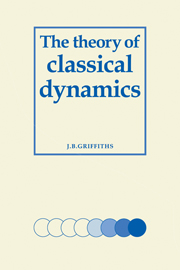Book contents
- Frontmatter
- Contents
- Prefaces
- Introduction
- 1 The Newtonian method
- 2 Space, time and vector notation
- 3 Force, mass and the law of motion
- 4 Newtonian relativity
- 5 Newtonian gravitation
- 6 Particle dynamics
- 7 Systems of several particles
- 8 Rigid body dynamics
- 9 Analytical dynamics
- 10 Variational principles
- 11 Hamilton–Jacobi theory
- Appendix list of basic results and definitions
- Suggestions for further reading
- Index
1 - The Newtonian method
Published online by Cambridge University Press: 25 October 2011
- Frontmatter
- Contents
- Prefaces
- Introduction
- 1 The Newtonian method
- 2 Space, time and vector notation
- 3 Force, mass and the law of motion
- 4 Newtonian relativity
- 5 Newtonian gravitation
- 6 Particle dynamics
- 7 Systems of several particles
- 8 Rigid body dynamics
- 9 Analytical dynamics
- 10 Variational principles
- 11 Hamilton–Jacobi theory
- Appendix list of basic results and definitions
- Suggestions for further reading
- Index
Summary
As with other scientific theories, theories of dynamics aim to contribute to an understanding and explanation of phenomena that occur in the real world. In the theories of dynamics, it is the general subject of motion that comes under investigation. The aim is to describe how objects move, and to suggest physical reasons as to why they move. In particular they should provide methods for analysing or predicting the motion of specific bodies, and also possibly suggest techniques for controlling the motion of some objects.
The theory known as classical or Newtonian dynamics, the subject of this book, is one such theory. Before describing it in detail, however, it is convenient to describe in general terms the way in which the theory is used. This is the purpose of this first chapter.
The technique of mathematical modelling
The basic method by which any theory of dynamics is applied can be described in terms of three distinct phases. The first phase consists essentially of constructing a simplified model. This is an idealised imaginary representation of some physical situation in the real world. In phase two this theoretical representation is analysed mathematically and its consequences are deduced on the basis of some assumed theory. Finally, in phase three, the theoretical results of phase two are interpreted and compared with observations of the real physical situation. This whole process can of course be repeated many times using different initial representations or different basic theories.
- Type
- Chapter
- Information
- The Theory of Classical Dynamics , pp. 1 - 15Publisher: Cambridge University PressPrint publication year: 1985



